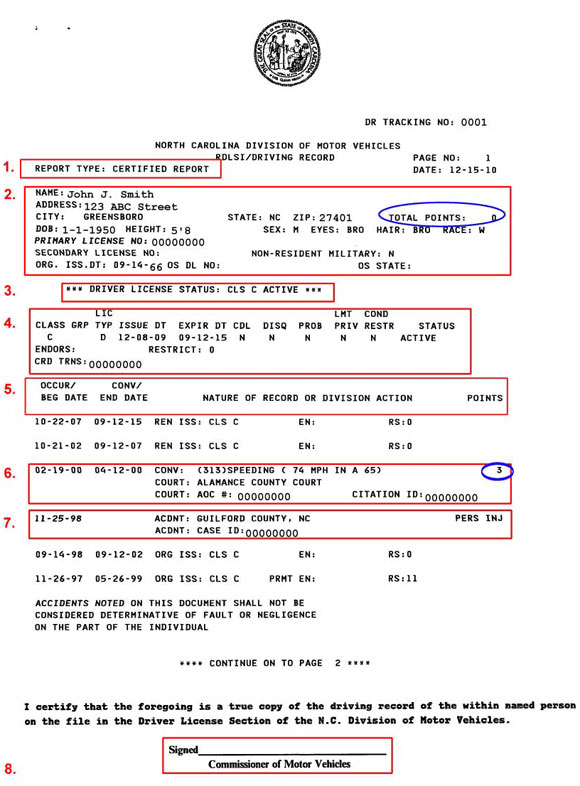How To Read Your Driving Record
Click Here to download this Guide
The following is a guide on how to read your North Carolina driving record. In the example record, we have either drawn a circle or square around each important portion of the record. Next to each circle or square is a number. Below the sample driving record, is a numbered list where a description is provided that corresponds with each numbered item in the sample record.

Box 1 – This box indicates the type of driving record in front of you. We recommend that you order a “certified” driving record if you plan to use the record in court.
Box 2 – This box lists your identification information such as your name, address, and driver’s license number. The most important piece of information in box 2 is circled in blue. This is your total number of Department of Motor Vehicles (DMV) points. The number of DMV points that you have can have a bearing on whether you are able to retain you driving privilege. For more information on DMV points.
Box 3 – This section tells you the current status of your North Carolina Driver’s License. In the example record, the driver’s license is active.
Box 4 – This area gives specific details about your current North Carolina Driver’s License, such as the date it was issued, when your Driver’s License is set to expire (if not renewed), and whether there are any type of restrictions associated with your Driver’s License.
Box 5 – This is the header of your actual driving record, and the corresponding information below Box 5 is the content of your driving record.
- Beginning on the left side of box 5, you have the “OCCUR/BEG DATE” column. This is the date you were charged with any traffic violations.
- Moving right in box 5, the next column is the “CONV/END DATE.” This is date that your traffic violation was disposed of by either a conviction, a guilty plea to a reduced charge, or a dismissal.
- Next in box 5 is “NATURE OF RECORD OR DIVISION ACTION.” This column tells you the nature of your traffic violation or event.
- Finally, on the far right column of box 5 is “Points.” This is the number of DMV points that you incurred because of the traffic violation or event.
Box 6 – This is the first entry on the sample driving record. As you can see, the driver was charged with speeding on 02-19-00 in Alamance County. Further, the driver was convicted of speeding, going 9 mph over the speed limit (74 mph in 65 zone) on 04-12-00. The driver received 3 DMV points as result of this conviction. It is important to note that North Carolina DMV points are much different than North Carolina insurance points (the driver in this sample record did not receive any North Carolina insurance points).
Box 7 – This box has the second entry on the sample driving record. This entry indicates that the driver was involved in an accident on 11-25-1998 in Guilford County, North Carolina. The entry also states that there was a personal injury that resulted in the accident. However, there were no criminal charges or traffic violations associated with the accident, nor did the driver receive any DMV points. Again, note that North Carolina DMV points are different than North Carolina insurance points.
Box 8 – This is the signature of the North Carolina Commissioner of Motor Vehicles certifying that the driving record is true and accurate. If you are using your driving record for court purposes, we recommend that use a certified copy of your driving record and that the driving record is signed by the North Carolina Commissioner.
Kreger Law Firm’s North Carolina Speeding Ticket Attorneys serve clients charged with speeding and other traffic violations in Durham County, Guilford County (including the cities of Gibsonville, Greensboro, High Point, Jamestown, Oak Ridge, Pleasant Garden, Sedalia, Stokesdale, Summerfield and Whitsett) and Orange County (including the cities of Carrboro, Chapel Hill and Hillsborough).
